Over time, furnaces have been replacing the conventional fireplace as the means to provide warmth in homes. Today, furnaces have emerged as the powerhouse behind every commercial, industrial, and residential heating system. With their diverse utility and beneficial features, the demand for furnaces is always high.
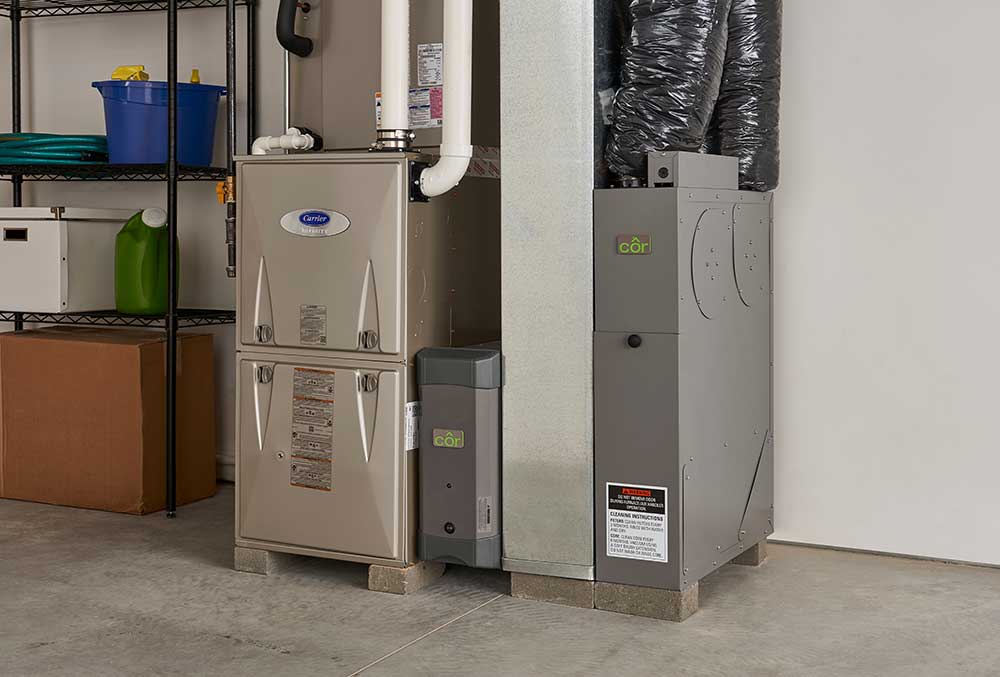
This is one of the reasons why the market is flooded with a variety of furnace options for you to consider, which is why the selection process can be challenging and time-consuming.
To help you with your furnace selection, we’ve broadly categorized the 30 types of furnaces into four easy-to-understand sections. So, without further ado, let’s get going!
Types of Furnaces

What Is a Furnace?
Before diving into the different types of furnaces available in the market, it makes sense to understand the unit’s purpose. A furnace is one of the main components of an HVAC system that activates once you set your thermostat. The fundamental principle is pretty much the same for every furnace; it takes in air, heats it up, and then distributes the warm air throughout your home or room (depending on its size).
To help you find the type of furnace that’s most appropriate for your home, we’ve divided our guide into four sections. Each section explains the different categories of the heating system in detail, allowing you to choose the best option.
Types of Furnaces Based On Efficiency and Design
In this section, we’ll be categorizing the general types of furnaces based on efficiency and design.
-
Natural Draft Furnaces

Known for its simple design and fewer controls, the natural draft is among the oldest types of furnaces. It depended fuel to create heat, but without a burner, it failed to circulate air into the room. Instead, any heat produced by the furnace would vent through chimneys made of masonry or brick.
Over time, homeowners utilized electric blowers to push the hot air out of the furnace and circulate it in the room. Natural draft furnaces with gas systems depend on a thermostat to control the amount of heat produced while coal or wood furnaces rely on the amount of fuel left in the system.
-
Forced Air Furnaces
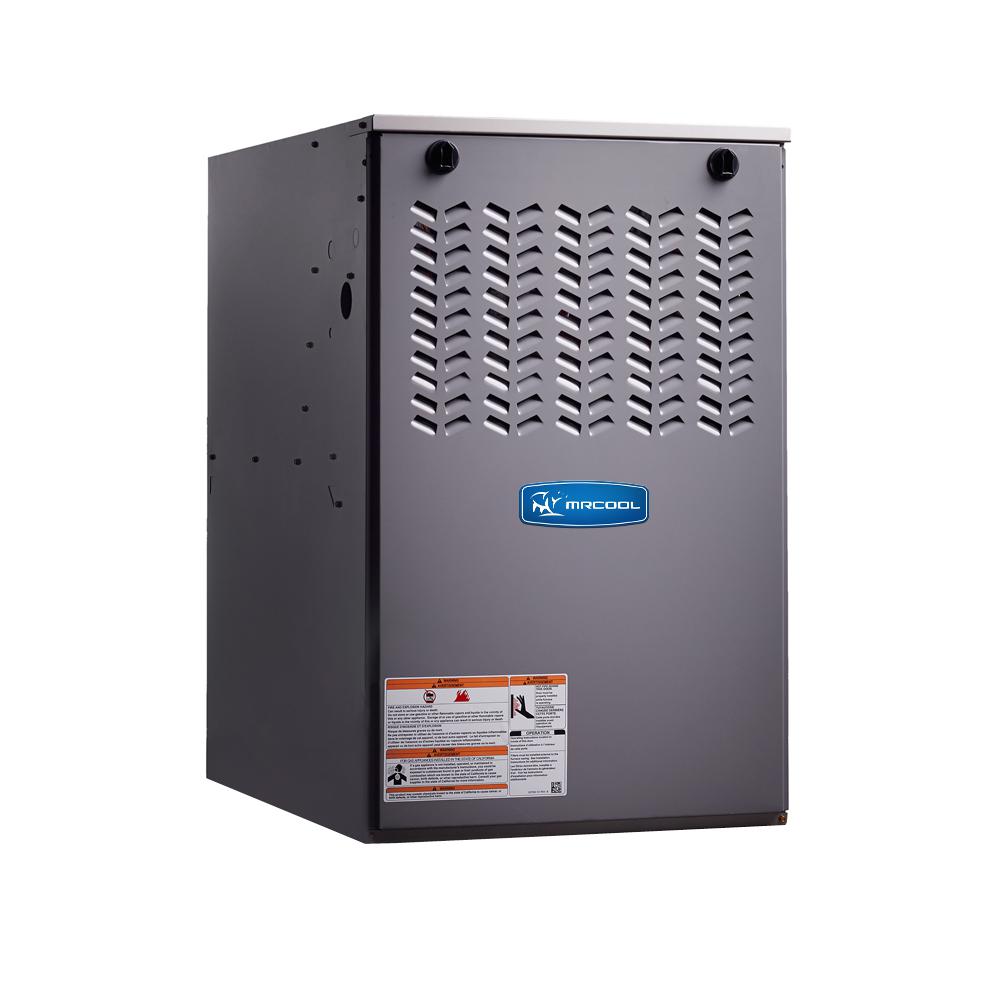
Forced air furnaces gained popularity in the 1950s and 1960s. They were more efficient than natural draft furnaces, but their annual fuel utilization efficiency can’t be compared to that of today.
Made using steel, they were bulky and could be installed on the same pipe system as the natural draft. However, unlike the latter, they came with blowers to distribute heat throughout the room.
That’s not all; forced air furnaces offered homeowners ample control over heat. They were connected to belts and later designed to work with air conditioners after relying on brick and masonry chimneys.
-
Forced Draft Furnaces

Taking efficiency a step further is the forced draft furnace, featuring a steel heat exchanger and a multi-speed blower. Consequently, the combustion air blower pulls air through the furnace’s heat exchanger, thereby increasing fuel efficiency.
The multi-speed blower also makes it convenient for homeowners to adjust the amount of heat being pumped into their homes for optimal comfort. What’s more, they are compact in size compared to older furnaces, making them perfect for every household.
-
Condensing Furnaces
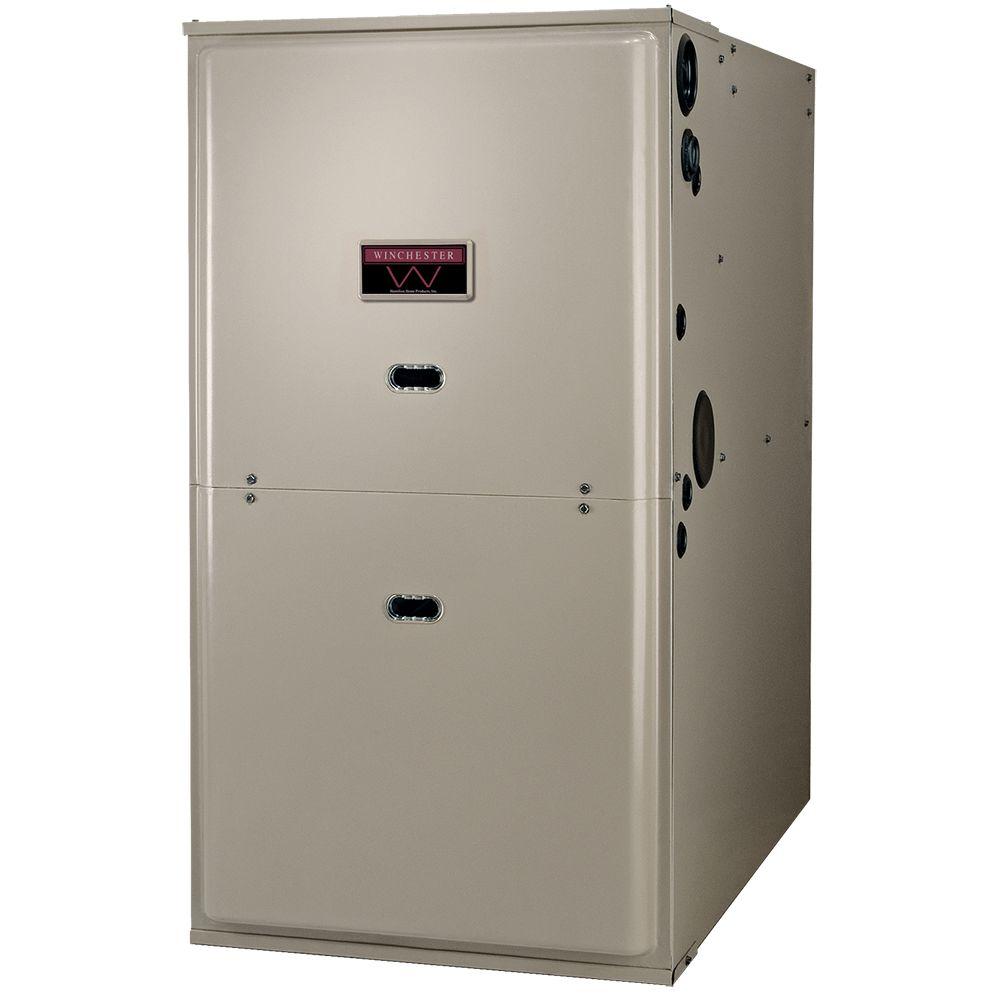
Condensing furnaces ensure high fuel efficiency, thanks to their combustion area, secondary heat exchanger, and draft inducer. During operation, the heat exchanger removes heat that’s released in the exhaust gas, condensing water vapors and other chemicals.
This makes the pipes strong enough to withstand the acids created by the chemicals. On the other hand, the draft inducer makes it easy for piping to be horizontal or vertical. This allows you to achieve the most efficient arrangement to help bring fresh air into the furnace from outside.
-
Single-Stage Furnaces
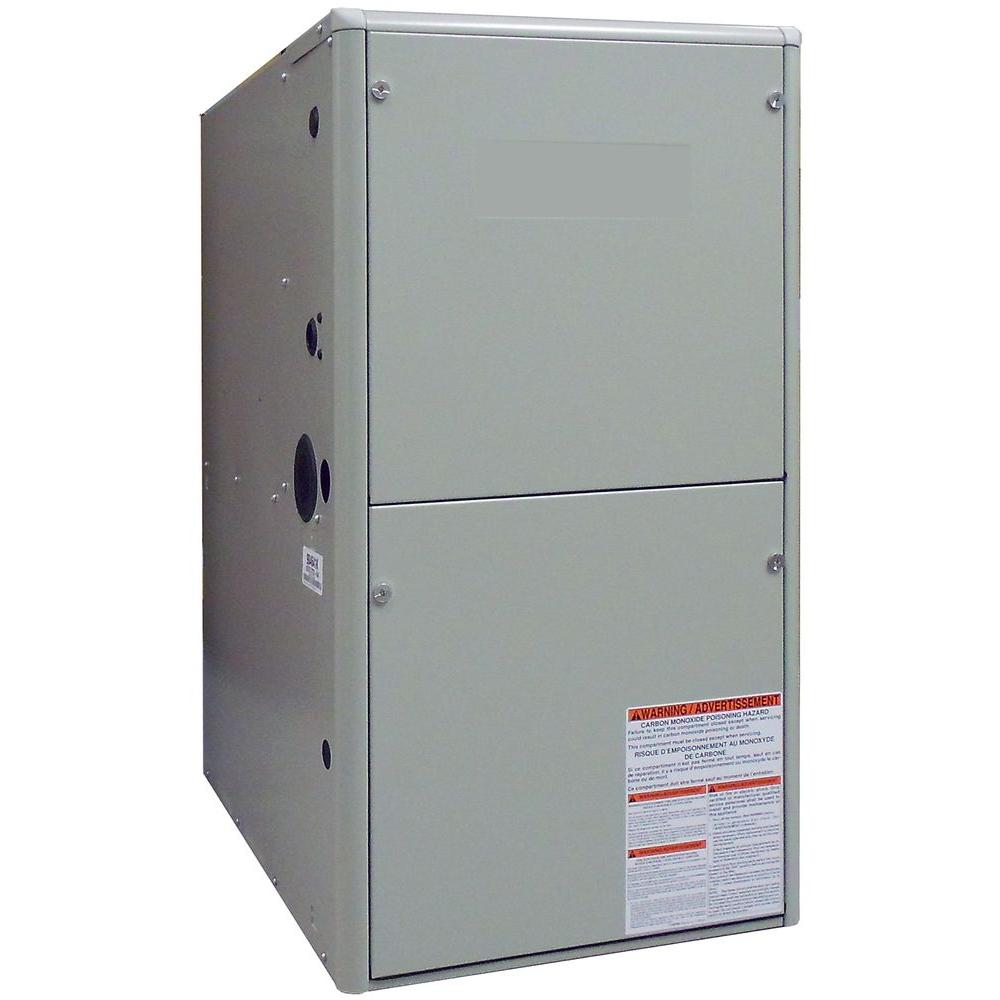
This furnace comes with a single gas valve that opens and closes to allow gas to flow at a high rate. Generally, single-stage furnaces are very noisy, running on only one speed while continuously pumping out hot air at a fast pace.
Perfect for mild to moderate areas, they keep you warm but fail to maximize savings per month, as they work at 80% annual fuel utilization efficiency.
-
Dual/Two-Stage Furnaces
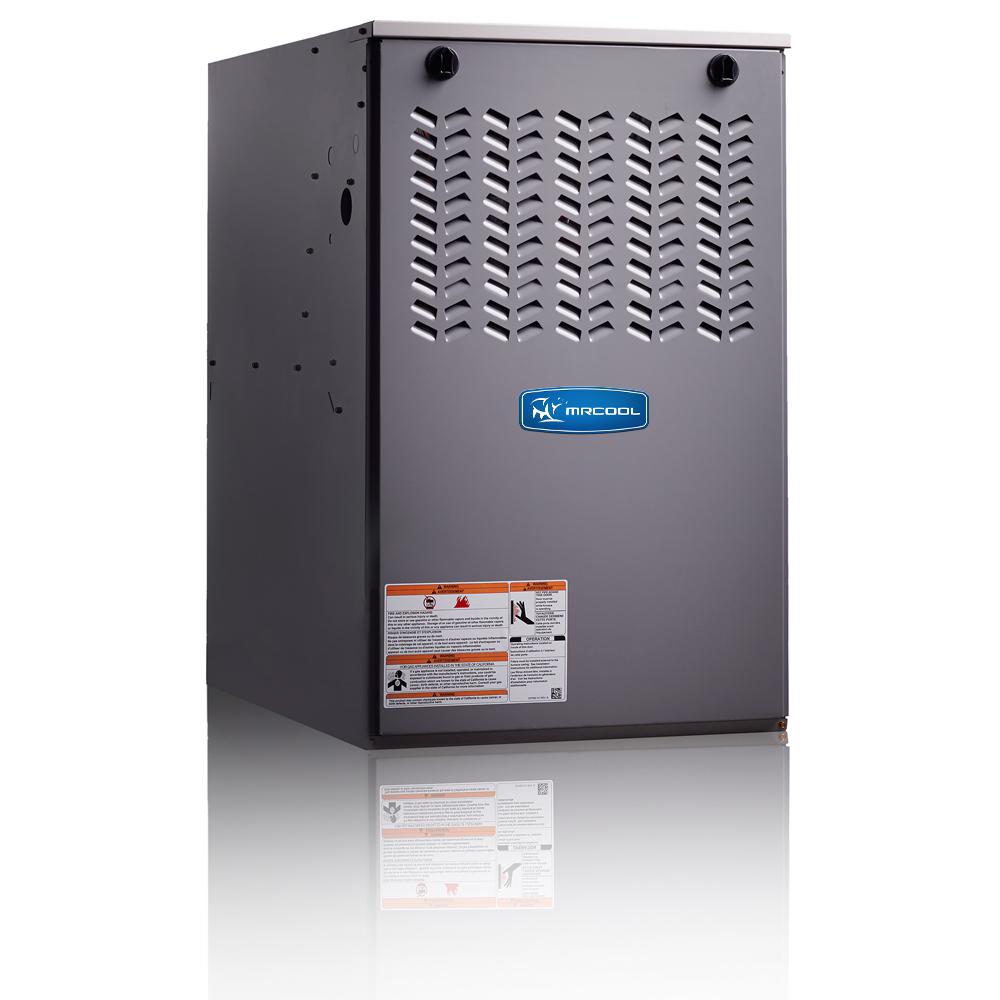
A two-stage furnace will offer more control over the flow of gas compared to its single-stage counterpart. You may easily choose between full or low power, depending on your requirements.
That’s not all; it can adjust according to the heating load of your home by communicating with the thermostat. In other words, the thermostat triggers the furnace to open up its valve, allowing full power when your home starts getting colder during the winters.
Operating at around 90% annual fuel utilization efficiency, it’s without a doubt one step above the single-stage furnace. It also comes with an extended heating cycle to ensure better air distribution throughout your room for optimum comfort.
-
Modulating Furnaces

A modulating furnace keeps adjusting the amount of heat released into your home to ensure optimal heating at all times. Although models vary, most units adjust their output after considering the temperature of your home.
The furnace is most commonly used in homes located in areas with long and cold winters where heat is demanded for an extended duration. Being highly efficient, it makes sense for homeowners to take advantage of the system, despite its hefty price tag.
Types of Furnaces Based on Fuel-Type
In this section, we’ll be shedding a light on the different types of furnaces based on the type of fuel utilized for heat generation.
-
Natural Gas Furnaces

Furnaces that use natural gas as their source of fuel are commonly used in most households, as they’re relatively inexpensive and easy to maintain. They don’t break down that often, so you need not bother about spending a lot on necessary repairs and replacement when required.
Not only that, but you don’t have to worry about causing pollution every time you turn on the furnace to heat up your home. This is because natural gas is the cleanest and most efficient form of fuel. Using a small amount of it will help produce optimal heat during the cold winter months.
-
Electric Furnaces

Nowadays, most homeowners prefer electric furnaces because they don’t require additional gas lines. This saves expenses on running pipework by calling professionals for the purpose.
With easy access to electricity, using this type of furnace to heat your home is more convenient than their natural gas counterparts. Being cost-effective, it serves as the ideal option for families on a tighter budget. In fact, electric furnaces are also more efficient than the other types of furnaces. You need not worry about toxic fumes or carbon monoxide leaks.
-
Oil-Fired Furnaces

You can definitely consider opting for an oil furnace if your home has the space for it, and you don’t mind having someone over to fill up its tank on a regular basis. However, in case your furnace runs out of oil, you’ll have to wait for the person to come back and refill it to heat your room again.
Besides these drawbacks, this furnace-type is relatively easy to maintain, but you’ll need to change the oil filters regularly to avoid the risk of a fire hazard. Apart from this, it’s important to note that despite being more reasonably priced compared to natural gas and electric filters, you’ll eventually end up paying more for the fuel itself. This is why we recommend weighing long-term benefits and savings before going ahead with this purchase.
-
Propane-Fueled Furnaces

Homeowners are turning to propane furnaces since they can be used almost anywhere, and they don’t require gas lines. All you need to do is connect the furnace to a large propane storage tank, and you’re good-to-go. However, like oil furnaces, a propane furnace also requires regular filling of its tank to prevent running out of fuel.
The best part of using this type of furnace is that it’s incredibly adaptable. You can simply opt to burn natural gas instead of propane in case of a shortage or price surge. Being hotter than any other fuel, it manages to heat up your home within no time by circulating hot air uniformly throughout the room. You’ll also be impressed by its durability as these furnaces are guaranteed to last for 20 years or more.
-
Coal Furnaces
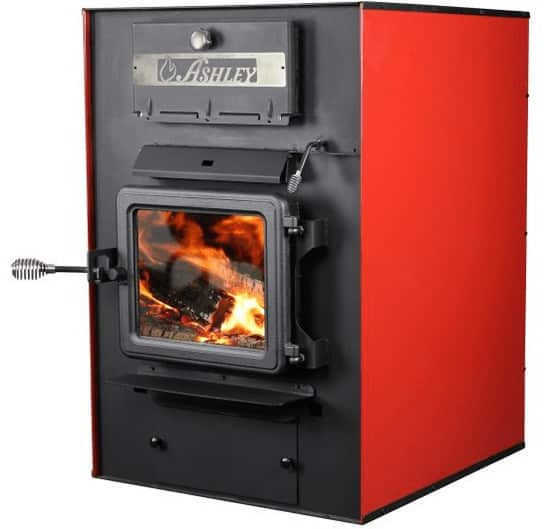
Equipped with fewer moving parts than the others, furnaces fueled by coal are less likely to break down and require extensive repair. That said, manufacturers are utilizing anthracite coal to fuel furnaces nowadays, as it produces high heat without the dangerous soot and smoke.
Unlike bituminous, anthracite coal is almost 100% carbon. Even though it prevents smell, be prepared to find dust and ash while cleaning out the furnace. Nonetheless, the fuel source is commendable as it’s both efficient and easy to manage.
-
Wood-Burning Furnaces
Looking for a dependable and efficient source of fuel for your furnace? It’s safe to say that wood is your best bet. It eliminates the high monthly heating bills, offering financial relief to those who use it. In fact, furnaces powered by wood can be used to heat a number of buildings at once by moving them outside, thereby reducing the risk of a fire hazard. To further ensure safety, make sure you clean and maintain them regularly.
A furnace free of rust and creosote will last as long as possible. On the other hand, a low-quality model without proper maintenance will serve its purpose for hardly a decade. Furthermore, the easy availability of wood makes this furnace-type high on demand, especially for people living in a large area of land who are able to harvest and cure their own wood.
-
Waste Oil Furnaces
These furnaces serve as green and environmental-friendly solutions, as they recycle waste automotive or vegetable oil that would have normally been disposed of.
When cleaned and maintained regularly, waste oil furnaces can last for 20 to 25 years, so you can rest assured of its efficiency and performance over time. However, it’s critical to keep in mind that waste oil can contain lubricants and pollutants, such as chromium, lead, and PCBs, which can be hazardous to health while heating.
This is why you should go by the EPA regulations to know which fuels are safe to burn. In some areas, users may need to purchase a permit and monitor their chimney emissions regularly to maintain the ecological balance of their surroundings.
-
Dual Fuel Furnaces
During cold weather, dual fuel furnaces fire up gas to distribute warm air throughout the room. On the other hand, they utilize a heat pump in the comparatively warmer months to maintain a comfortable temperature at all times.
The heat pump takes air from the outdoors to warm your indoor space. Its air handler passes the air over a hot refrigerant while the fan circulates the warm air evenly throughout your home.
Dual fuel furnaces are considered to be one of the most efficient types of furnaces on the market. Even though its initial installation and system up-gradation may be expensive, the system saves on energy consumption and associated costs.
Types of Industrial Furnaces
The primary goal for each industrial furnace remains the same - attaining the highest level of heat both efficiently and uniformly. On that note, we’ll be discussing the types of furnaces used in industries for metal and material processing.
-
Bell Furnaces
Bell furnaces are electrically heated, thermal recirculation heating, or gas-fired systems that include a movable dome. Ideally, these units are used to temper, normalize, anneal, and stress relieve steel plate formed parts. However, they can also be used with multiple bases to provide reliable seals, treat strips, coils, sheets, rods, and more.
-
Box Furnaces
Featuring vertical lifts or swing-open doors, box furnaces ensure a consistent airflow while used for heat-treating, curing, calcining, preheating, tempering, and other processes. Available in both electric and gas variants, they accept heavy-loads to support industrial and laboratory applications.
-
Quenching Furnaces
These furnaces come with an enclosed heating chamber to prevent low-temperature processes like phase transformation. Its rapid and controlled cooling hardens the material to prevent uneven heating and overheating. However, you can also perform the tempering technique once the quenching process is over to increase toughness.
Having said that, gears, bearing components, fasteners, and agricultural machinery components are a few products processed in quenching furnaces.
-
Forging Furnaces
Many people often confuse forging furnaces with pizza ovens because of their uncanny resemblance. They transmit heat via radiation to bring the temperature of the metal to a point at which it can be forged, or to stop the hardening process.
-
Rotary Furnaces
This industrial furnace-type, ideally used for calcination and oxidation, features a lined furnace welded from steel into a barrel shape. Mounted on a drive, it rotates the barrel throughout the heat treatment while the material is mixed by tilting the furnace during the process.
What’s more, these units are highly efficient with easy pasteurization, providing heat uniformity with good material contact. As far as the internal heat source goes, it can be either electric or gas with a flow of muffled combustion gases.
-
Tempering Furnaces
These furnaces are designed to heat-treat ferrous metal products in order to increase their toughness. That said, heat-treating certain high strength materials may impact the energy absorption and alloy’s formation.
This is why tempering furnaces are often used with quenching furnaces to achieve the best balance of strength and elasticity. For this, it’s crucial to maintain uniform temperature levels throughout the furnace’s chamber. Only then will you be able to achieve the desired material characteristics.
-
Vacuum Furnaces
You’ll find a vacuum furnace in almost all industries. What makes it stand out from the other types of furnaces is the vacuum, which is maintained throughout the heating process. This, in turn, protects the heated steel and metal parts from overheating and damage.
Ideally these furnaces are used for brazing, sintering, heat treatment, and annealing. Vacuum furnaces, whether they’re gas heated or electric, also include pumps to prevent oxidation, heat loss, and contamination.
-
Salt Bath Furnaces
Salt bath furnaces are used to treat high-speed steel and other edge tools, annealing stainless steels and nickel-chrome alloys, and brazing automotive radiators. Utilizing high heat transfer characteristics of convection, they help achieve fast heating of metal parts, typically five times that rate of air furnaces.
These furnaces are usually powered by electrodes immersed directly in molten salt. The temperature of the bath depends on the types of salts used, such as cyanide and chloride mixtures, with temperatures ranging anywhere between 300 to 2350 degrees Fahrenheit.
Depending on the temperature during operation, ceramic or metal pots are used for the process. While the electrodes are preferably mild or high chromium steel, typically square-edged, and not round, to maximize magnetic flux. That being said, the electrodes can be controlled through a tap changing transformer to help you adjust the power as required.
-
Pit Furnaces
For those who don’t know, a pit furnace is commonly known as a top-load furnace, and it’s often available as a variant of an electric or gas furnace. Mainly used in automotive and aircraft manufacturing, the unit also helps in mining, machine building, and generating wind energy.
Types of Furnaces Based On Features and Airflow
This section will take you through an in-depth analysis of the different types of furnaces categorized based on their features and airflow.
-
Sealed Combustion Furnaces

Furnaces that come with sealed combustion not only protect you and your family from the risk of carbon monoxide, but they also offer energy efficiency. Plus, they retain the heat for a longer period of time to ensure that your home is efficiently and evenly heated at all times.
-
Energy Star Rated Furnaces
Energy rated furnaces come with an annual fuel utilization efficiency of more than 90%. It makes sense to categorize these models selected by the US Department of Energy and the US Environmental Protection Agency as a type of furnace because, unlike other units, they help in saving energy.
Ideally, furnaces that come with an energy star rating use 20% to 30% less energy than what’s required by the mandates from the government. As a result, they lower expenses by saving on electricity bills. This is one of the crucial reasons why they’re growing in popularity among the homeowners of today.
-
Smart Furnaces
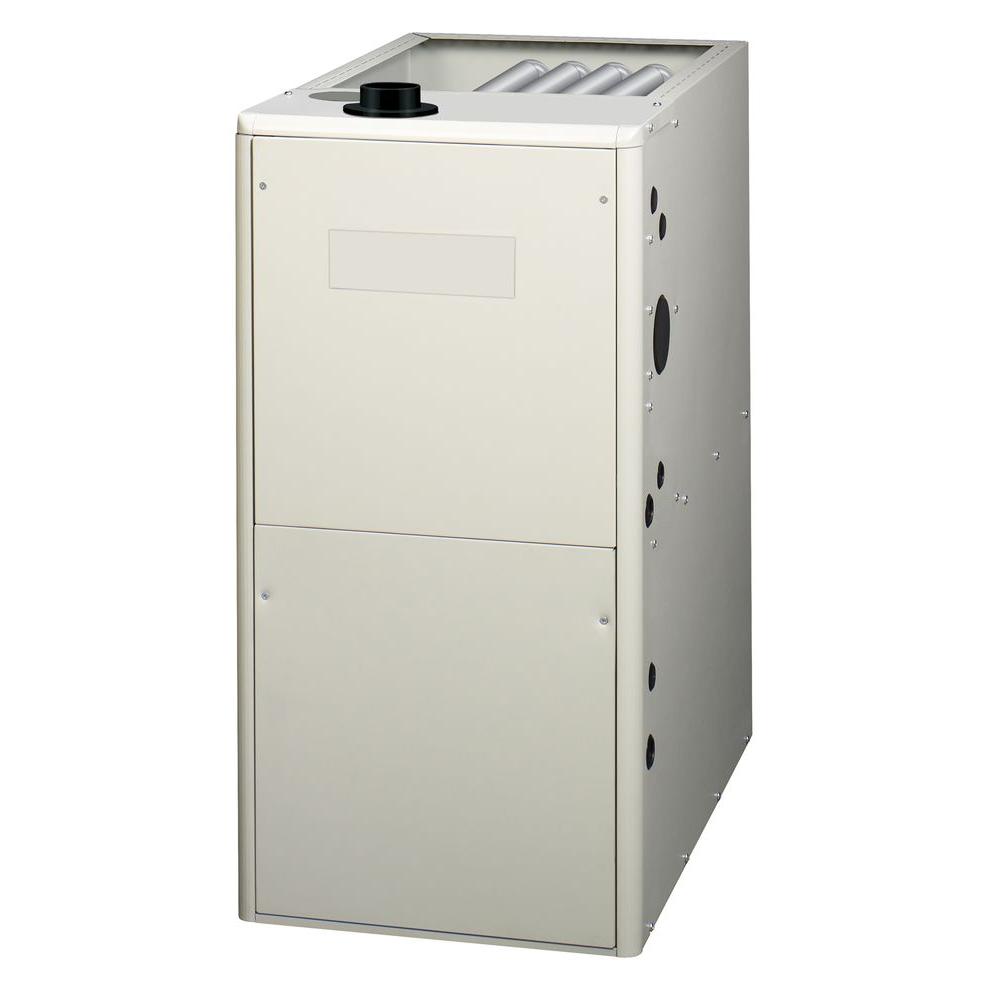
Don’t mind spending a few extra bucks? In that case, we’d suggest considering a furnace equipped with smart technology to make your life more convenient. These models come with intelligent controls that notify you when it’s time to change the filter.
They also allow you to monitor the airflow and adjust the zones at home. Even when you’re not at home, smart furnaces help you keep a close watch on the interior and exterior temperature of your home using any device, be it a smartphone or a tablet.
-
Upflow Furnaces
These furnaces draw in cool air through their base, and then they push out the warm air through the top. Hence, they’re perfect for homes where the ductwork is usually above the furnace.
-
Downflow Furnaces
Downflow furnaces differ from upflow furnaces in their heating mechanism. These units intake cool air from the top and release the warm air from their base. As such, they’re ideal for places where the ductwork is below the furnace.
-
Horizontal Furnaces

Perfect for attics or basements, horizontal furnaces are designed to lie on their sides, so they don’t require much vertical space. They intake air from one side and release the warmth from the other. Plus, they’re available in two variants - upflow/horizontal and downflow/horizontal.
Factors to Consider When Choosing a Furnace
Even after reading this extensive list, deciding on a suitable type of furnace for home or industrial use isn’t a simple choice. This is why we have a few crucial points for you to consider while considering your options.
-
The Right Size
You might have decided on the type of furnace for heating your home or office space, but that’s not enough. Make sure you choose the right size (measured in BTUs) based on the size of the area, ceiling height, local climate, and the number of doors and windows.
-
Climate and Region
It’s important to opt for a furnace-type that suits where you live. This will help you determine the climate and availability of energy resources. An open area with the provision of curing or harvesting wood is perfect for wood-burning furnaces. On the other hand, electric variants are ideal for areas with a lack of natural energy resources.
-
Brands
The brand name often serves as a source of reliability, so it’s equally important to consider the brand before settling on a furnace. Oil and gas furnaces from American Standard, Rheem, and Trane are highly rated for efficiency, price, and performance, while Carrier and Goodman are often considered while buying electric furnaces.
Final Words
Believe it or not, furnaces have a long history of heating homes dating back to the Roman era, 1200 BCE. Utilizing a heating-system referred to as “hypocaust,” they used to distribute heat in palaces and kingdoms until the fall of the Roman empire. These systems also regained popularity in the 13th century.
Modern furnaces aren’t just heating systems used to warm the air of your room, home, or building; The thermal energy obtained from these units can also be used to process metal and materials in industries. As such, they have many commercial and industrial applications as well.
We hope this guide assists you when making your final decision.
